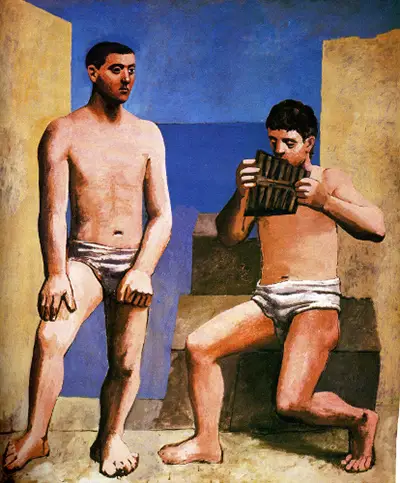This new Classical style was influenced by classical Greek and Roman art. The trend was characteristic of weighty and serene figures, donning robes in tactile, yet simple landscapes.
The Classical trend in art would go on to dominate the stage in Europe for over a decade. Picasso emerged as a leading figure in this new art direction.
During the early stages of this period, his primary focus was on drawing and painting, which he did mostly for his personal exploration.
Picasso was a renowned artist with unsurpassed mastery of skill and technique. This is why his first trip to Italy in 1917 acted as a stimulus to breaking away from modern extremism and following in the steps of artists such as Raphael and Ingres.
Picasso met Olga Kolkova, a Russian Ballerina in 1918. They eventually married, and due to her high social standings, Picasso began to move in different social circles.
This was different from the Bohemian lifestyle he was used to. This seemed to have an effect in his work. For example, he ceased from being more provocative and began gravitating towards more traditional and serious artworks. He referred to this new found style as “classicist.” His masterpiece “The Lovers,” is an example of how his style changed with his social change. The Pipes of Pan is also another famous composition from the classical period.
Picasso still continued finding fascination with the decoration of the ballet production. The birth of his first son Paul, inspired him to return to the “mother and son” theme again and again. He would however go back and work on Cubism, as evidenced in his 1921 painting The Three Musicians. The writings of Sigmund Freud, a renowned psychologist, also had a profound effect on Picasso’s work.
Picasso painted “The Pipes of Pan” in 1923, which is often regarded as one of his most important artwork of the classical period. It is a depiction of two men, one playing pipes, while the other listening to the music. The pipes of Pan symbolize the Greek god of music, the wild, mountains, nature, shepherds and flocks.
Mythological Greek has it that he has the legs and horns of a goat. The pan flute symbolizes peace and nature. This artwork is seen as Picasso’s crowning achievement of the classical period of the 1920s. This particular piece highlights the influence that Greco-Roman art had on Picasso during his travels in Italy.
During this period, as quoted in Picasso’s quotes, he claims that God chastises an artist by giving him the misfortune of fame. Picasso was of the opinion that fame was a worse misfortune than hunger and misery. Picasso had come to grow both in fame and stature during the mid-twenties.
He however did not take this increased fame positively since he perceived that the public was suppressing his individuality by applauding every single artwork he produced without critically looking at it. In addition, Picasso was having marital problems. His wife Olga, a ballerina dancer who thrived in fame and high social standing, could not understand why Picasso was uncomfortable with fame.
The negative effects of World War 1 sent many Parisians to the war front. However, Picasso, a foreign national, continued working largely undisturbed. He even travelled to the Italy and the south of France for the first time. Since he was experienced in the art of Pompeii and ancient Rome, this brought renewed emphasis and acted as a stimulus on his renewed interest in classical art.
The turmoil of the war in Europe led to a return to order in Europe. It was seen as a reaction against modernist extremist movements such as expressionism and cubism. Artists such as Picasso began condensing and simplifying their styles to fit this new order. Some of the other prominent artists who followed suit include artists of the New Objectivity movement, Giorgio de Chirico and André Derain.
Pablo Picasso was born in Spain in 1881. He was raised there before moving to France where he spent most of his adult life working as an artist.
Renowned as one of the most celebrated artists in history, he created more than 20,000 pieces of art which included drawings, sculptures, painting and ceramics among others. Most of his work has been divided by periods of time in which he developed art along complex themes and feelings.
Blue Period
The Blue Period (1901-1904), was a time when Picasso experienced poverty. His works during this period are characteristic of themes such as prostitution, malnutrition and the gloomy portrayal of his friend’s inner torment after he commits suicide. Most of the colours used in his works from this period were mainly blue. One such art piece is the portrait of Suzanne Bloch.
Rose Period
In the Rose Period (1904-1906), Picasso seems to start experiencing success and even falls in love. This prompts him to start making more optimistic paintings. He mainly uses pink and orange in his artwork. He painted Garçon à la Pipe (Boy with a Pipe), which turned out to be one of his most highly priced painting.
The African Influence Period
During the African Influence period (1907-1909), the wave of traditional African aesthetics began to make inroads among European Artists. It was a period inspired by African sculpture and Picasso was not to be left behind. The Les Demoiselles d'Avignon (The young girls of Avignon) is one of his famous artworks during this period.
The Cubism movement
This was to be followed by the Cubism movement (1909-1919). It was a period when Picasso and Braque developed a style in which they emphasized the combinations of forms in the picture.
They would use non-painted objects such as newspapers and combine them in the canvas along with painted areas to create a form of collage. The Italian Girl is a good example of artwork during this period.

